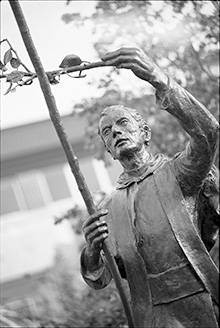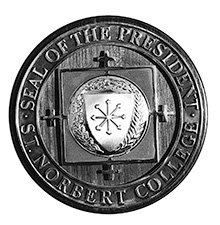
Symbols and Their Meanings


In medieval times, a mace was a spiked club wielding effective authority among combatants. Later, it became a conventional symbol of authority, and, when vested within the academic community, it often signifies teaching authority.
The teaching mission of St. Norbert College offers preparation for all good works. The college mace bears a cross theme since preparation for good works is rooted in a full awareness of the significance of the cross.
The design is one of dynamic contrast. There is an interplay of contrasting and diametrically opposed sculptural elements, which serve to symbolize the richness of Christian values. A cross with its extension of equal arms in four directions in brilliant gold is suggestive of peace (“the tranquility of order”), richness, brilliance and smoothness. The four roughly hammered elements (suggestive of the world) are in diametric opposition and are of contrasting color and texture, which suggests the opposite of the cross, i.e., disorder, poverty, darkness and roughness.
The ebony surface is carved with a number of abstract forms suggestive of constituent elements that are separate yet integral with the whole (community). At the top of the staff are three sterling medallions — the seal of the Norbertine fathers, the seal of the college and the seal of Wisconsin.
The St. Norbert mace symbolizes the communal spirit that presents the cross with its richness and imparts its significance and worth to a darkened, impoverished and contrary world environment.
This mace was designed and crafted by Paul A. Cavanagh, Greenville, Rhode Island, in 1983.
The Sculpture of St. Norbert
Norbert of Xanten was born on the German-Dutch border in the Castle of Gennep c.1075. His father was the count of Gennep, and his mother was a cousin of Emperor Henry IV.

After serving in the courts of the archbishop of Cologne and of the emperor, St. Norbert decided to undertake a life of poverty and simplicity. After years as an itinerant preacher, he settled in the valley of Prémontré, France, and founded the Premonstratensian order in 1120. In 1126, he was chosen as archbishop of Magdeburg.
The sculpture captures St. Norbert as a young itinerant preacher. The Norbertine scapular stole and cincture identify the order that he founded. Holding his walking stick in one hand, he impulsively plucks a living branch and forms a cross that is symbolic of the renewing of the church he seeks. With the cross as a focus, he strides up an inclined path that faces off the campus toward the outside community.
St. Norbert models for all ages selfless sharing and reaching out to allothers with love. Following his lead, graduates are encouraged to take their knowledge, service and leadership gifts out into the world.
The bronze sculpture was designed and handcrafted by Paul T. Granlund, sculptor-in-residence at Gustavus Adolphus College in St. Peter, Minnesota. Mary and Norman Watermolen ’47 underwrote the project with assistance from the St. Norbert College Centennial Class of 1998.
Seal of the President of St. Norbert College
The seal symbolizes the responsibilities of the president to provide leadership to the academic community, to ensure the continuation of the tradition and heritage of the college, and to represent the college to other constituencies.

The circle connotes responsibility, as there is an encompassment and integration of what is within. The square symbolizes the academic community: administration, faculty, student body and alumni.
The crest in the center symbolizes the heritage of the college. The cross extensions suggest the emanation of Christian values. All are within the outer circle, within the aegis of the president.
The disc on the reverse side is a suitable location for the names of the college’s presidents. The metal has been hand-wrought. The wood is ebony.
This presidential medallion was designed and sculpted by Paul A. Cavanagh, Greenville, Rhode Island,
in 1983.












